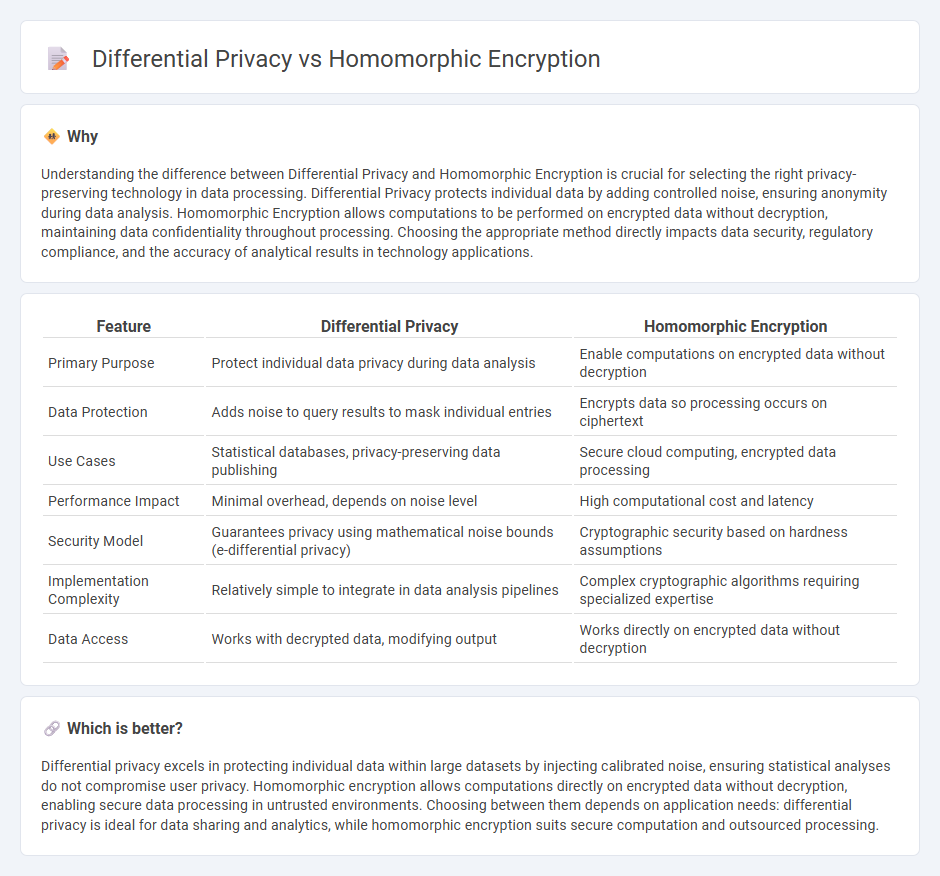
Differential privacy and homomorphic encryption are advanced techniques designed to protect data privacy in various applications. Differential privacy ensures individual data remains confidential by adding controlled noise to datasets, while homomorphic encryption allows computations on encrypted data without exposing the raw information. Explore deeper insights into how these cutting-edge technologies safeguard sensitive information in the digital age.
Why it is important
Understanding the difference between Differential Privacy and Homomorphic Encryption is crucial for selecting the right privacy-preserving technology in data processing. Differential Privacy protects individual data by adding controlled noise, ensuring anonymity during data analysis. Homomorphic Encryption allows computations to be performed on encrypted data without decryption, maintaining data confidentiality throughout processing. Choosing the appropriate method directly impacts data security, regulatory compliance, and the accuracy of analytical results in technology applications.
Comparison Table
| Feature | Differential Privacy | Homomorphic Encryption |
|---|---|---|
| Primary Purpose | Protect individual data privacy during data analysis | Enable computations on encrypted data without decryption |
| Data Protection | Adds noise to query results to mask individual entries | Encrypts data so processing occurs on ciphertext |
| Use Cases | Statistical databases, privacy-preserving data publishing | Secure cloud computing, encrypted data processing |
| Performance Impact | Minimal overhead, depends on noise level | High computational cost and latency |
| Security Model | Guarantees privacy using mathematical noise bounds (e-differential privacy) | Cryptographic security based on hardness assumptions |
| Implementation Complexity | Relatively simple to integrate in data analysis pipelines | Complex cryptographic algorithms requiring specialized expertise |
| Data Access | Works with decrypted data, modifying output | Works directly on encrypted data without decryption |
Which is better?
Differential privacy excels in protecting individual data within large datasets by injecting calibrated noise, ensuring statistical analyses do not compromise user privacy. Homomorphic encryption allows computations directly on encrypted data without decryption, enabling secure data processing in untrusted environments. Choosing between them depends on application needs: differential privacy is ideal for data sharing and analytics, while homomorphic encryption suits secure computation and outsourced processing.
Connection
Differential privacy and homomorphic encryption both enhance data security by enabling privacy-preserving computations on sensitive information. Differential privacy adds statistical noise to data outputs, ensuring individual data points remain indistinguishable, while homomorphic encryption allows computations on encrypted data without decryption. Their integration supports secure data analysis in fields like healthcare and finance by protecting user privacy throughout the data processing lifecycle.
Key Terms
Computation on Encrypted Data
Homomorphic encryption enables computation directly on encrypted data without requiring decryption, preserving data confidentiality throughout processing, which is crucial for secure cloud computing and privacy-preserving machine learning. Differential privacy, by contrast, adds noise to data or query results to protect individual privacy but does not support computations on encrypted inputs, making it less suitable for secure data processing tasks. Explore further to understand the trade-offs and use cases of homomorphic encryption and differential privacy in secure data analytics.
Noise Injection
Homomorphic encryption enables computations on encrypted data without decryption, preserving data privacy by transforming input into ciphertext that can be processed directly. Differential privacy introduces noise injection to the output of data queries, ensuring that individual data points cannot be distinguished, thus protecting privacy by adding statistical uncertainty. Explore the distinct advantages and practical applications of noise injection in both homomorphic encryption and differential privacy to better understand their roles in secure data analysis.
Data Utility
Homomorphic encryption enables computations on encrypted data without decryption, preserving data utility by allowing exact results while maintaining privacy. Differential privacy adds controlled noise to datasets, trading off some accuracy for strong privacy guarantees, which can reduce data utility in certain analyses. Explore more about balancing privacy and utility in these advanced data protection methods.
Source and External Links
Homomorphic encryption - Wikipedia - Homomorphic encryption is a cryptographic method that allows computations to be performed directly on encrypted data without needing to decrypt it first, preserving data privacy throughout the process.
What is homomorphic encryption, and why isn't it ... - Homomorphic encryption algorithms enable mathematical operations on encrypted data while maintaining strong security, ensuring that operations on ciphertexts correspond correctly to operations on plaintexts without revealing sensitive information.
What Is Homomorphic Encryption? - Chainlink - Homomorphic encryption comes in several types, ranging from partially homomorphic (supporting only addition or multiplication) to fully homomorphic (supporting arbitrary computations on encrypted data), with each type offering different levels of computational flexibility and practical use cases.
 dowidth.com
dowidth.com